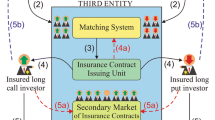Abstract
Margining is a crucial brokerage operation. In application to option portfolios it becomes exceptionally challenging because margin offsets with options require solving a highly intractable integer program. All these offsets are based on option spreads with a maximum of four legs. Although option spreads with more than four legs can be traced in regulatory literature of 2003, they have not yet been studied and used. Their usage in margin calculations would substantially increase the size of the program and therefore make it practically unsolvable. On the other hand, option spreads with more than four legs would allow the brokers to substantially increase the accuracy of margin calculations for option portfolios. In this paper we develop a theoretical framework for option spreads with any number of legs. We show that these spreads can be naturally described by homomorphisms of free abelian groups associated with option portfolios and option spreads with up to four legs. Using this observation we propose alternative integer programs that use option spreads with any number of legs and whose size does not depend on the number of legs. These programs can be solved in reasonable time and substantially increase the accuracy of margin calculations for option portfolios.

Similar content being viewed by others
Notes
We do not discuss here cross-margining principles for offsets involving positions with different underlying instruments. These principles are the same for both approaches; cf. Lindsey and Pecora (1998).
For example, the lowest and highest valuation points for a stock should be 15 % lower and higher than its current market price. These percentages follow SEC Rule 15c3–1a, section (b)(1)(i)(B), for net capital requirements of brokers or dealers.
The U.S. Securities and Exchange Commission.
The National Association of Securities Dealers.
The New York Stock Exchange.
Margin account equity is the total market value of all its positions, where long/short positions have positive/negative market values.
The Options Clearing Corporation.
The Chicago Board Options Exchange.
In 2007, the NASD merged with the NYSE’s regulation committee to form the Financial Industry Regulatory Authority, or FINRA.
Offsets of minimal quantity; see Sec. 2.1 for formal definition.
A leg of an option spread or offset based on this spread is a position in options with the same exercise price and expiry date.
For example, according to http://finance.google.com, as of 2 Aug. 2011, 5:50 p.m., exercise prices of options on the IBM stock listed in NYSE and expiring on 20 Aug. 2011 generated the uniform exercise domain \(\{85,90,\ldots ,270\}\) of dimension \(38\).
The term debit/credit indicates that the spread is a result of a net debit/credit transaction.
A negative quantity of a spread should be interpreted as a positive quantity of its negation.
The regulatory definitions given in SEC Release 34-52738, the CBOE Regulatory Circular and NYSE Rule 431 imply only these seven types. The CBOE gave some of complex spreads the same names as those of their resulting main spreads. To avoid confusions, we do not use these names. We should also emphasize that this paper presents our mathematical interpretation of CBOE’s informal definitions of complex spreads in a text form. Our goal was to follow the idea given in the definitions as close as possible and, at the same time, avoid inconsistencies that we found in them. Any omission that someone may find in our mathematical interpretation of CBOE’s complex spreads will be our responsibility.
Table 5 CBOE’s complex spreads, their components and resulting spreads Centipedes, as all other creatures, have even number of legs (one pair of legs per body segment), and this number can reach 200 and more. Centipedes usually do not bite humans but a few species, when provoked, can bite inflicting painful wounds. Millipedes are creatures with number of legs multiple of four (two pairs of legs per body segment). Some species have over 400 legs. Millipedes are not predators as centipedes—Wikipedia (terrestrial animals). One can observe that multi-leg spreads introduced in this section have similar properties if their legs are counted not as positions in options but as option contracts involved.
Some researchers provide evidence that the distribution of trades of main spreads is not uniform in certain option markets. For example, options on Eurodollar futures in 1999–2000, see Chaput and Ederington (2003), and options on the FTSE 100 Index in 2001–2004, see Fahlenbrach and Sandås (2010), were more frequently traded in spreads with two legs than spreads with three or four legs. One could argue that a similar trend should take place for stock options on NASDAQ: AAPL in 2011 (the year of our dataset), however, the stock market in 2011 was very volatile. Therefore, volatility option strategies which use spreads with three or four legs may have been traded more frequently than spreads with two legs. Under the absence of any data on these trades, we believe that using a uniform distribution of main spreads in option portfolios is justified.
References
Benzion U, Danan S, Yagil J (2005) Box spread strategies and arbitrage opportunities. J Deriv 12(3):47–62
Bharadwaj A, Wiggins JB (2001) Box spread and put–call parity tests for the S &P 500 index LEAPS market. J Deriv 8(4):62–71
CBOE (2000) Chicago Board options exchange margin manual. April
CBOE (2003) Regulatory circular RG03-066. August 13
CBOE (2004) Regulatory circular RG04-90. August 16
CBOE (2005) Regulatory circular RG05-37. April 6
Chaput JS, Ederington LH (2003) Option spreads and combinations trading. J Deriv 10(4):70–88
Coffman EG Jr, Matsypura D, Timkovsky VG (2010) Strategy vs risk in margining portfolios of options. 4OR 8(4):375–386
Cohen G (2005) The bible of options strategies. Financial Times Prentice Hall, Pearson, New Jersey
Curley MT (2008) Margin trading from A to Z: a complete guide to borrowing, investing and regulation. Wiley, New Jersey
Fahlenbrach R, Sandås P (2010) Does information drive trading in option strategies? J Bank Financ 34:2370–2385
Fortune P (2000) Margin requirements, margin loans, and margin rates: practice and principles. New Engl Econ Rev 3:19–44
Fortune P (2003) Margin requirements across equity-related instruments: how level is the playing field? New Engl Econ Rev 1:29–50
Griffith PA (1970) Infinite abelian group theory, Chicago lectures in mathematics. University of Chicago Press, Chicago
IDA (2007) Bulletin 3654
Kupiec PH (1998) Margin requirements, volatility and market integrity: what have we learned since the crash? J Financ Serv Res 13(3):231–255
Lindsey RR, Pecora AP (1998) Ten years after: regulatory developments in the securities markets since the 1987 market break. J Financ Serv Res 13(3):283–314
Luckett DG (1982) On the effectiveness of the federal reserve’s margin requirements. J Financ 37(3): 783–795
Matsypura D, Timkovsky VG (2012a) Margining component of the stock market crash of october 2008: a lesson of the straggle with combinatorial complexity. In: Proceedings of 1st International Conference Operations Research and Enterprise Systems, SciTePress, pp 484–489
Matsypura D, Timkovsky VG (2012b) Strategy vs risk in margining portfolios of options. Networks 60(2):120–131
McMillan LG (2002) Options as a strategic investment, 4th edn. Prentice Hall, Upper Saddle River
Moore TG (1966) Stock market margin requirements. J Polit Econ 74(2):158–167
Ronn AG, Ronn EI (1989) The box-spread arbitrage: theory, tests and investment strategies. Rev Financ Stud 2(1):91–108
SEC (2005a) Release 34–52031
SEC (2005b) Release 34–52738
SEC (2006) Release 34–54918
Author information
Authors and Affiliations
Corresponding author
Rights and permissions
About this article
Cite this article
Matsypura, D., Timkovsky, V. Integer programs for margining option portfolios by option spreads with more than four legs. Comput Manag Sci 10, 51–76 (2013). https://doi.org/10.1007/s10287-012-0159-x
Received:
Accepted:
Published:
Issue Date:
DOI: https://doi.org/10.1007/s10287-012-0159-x




